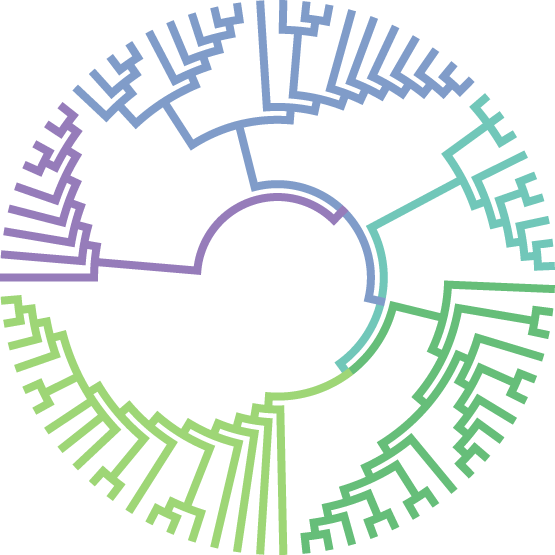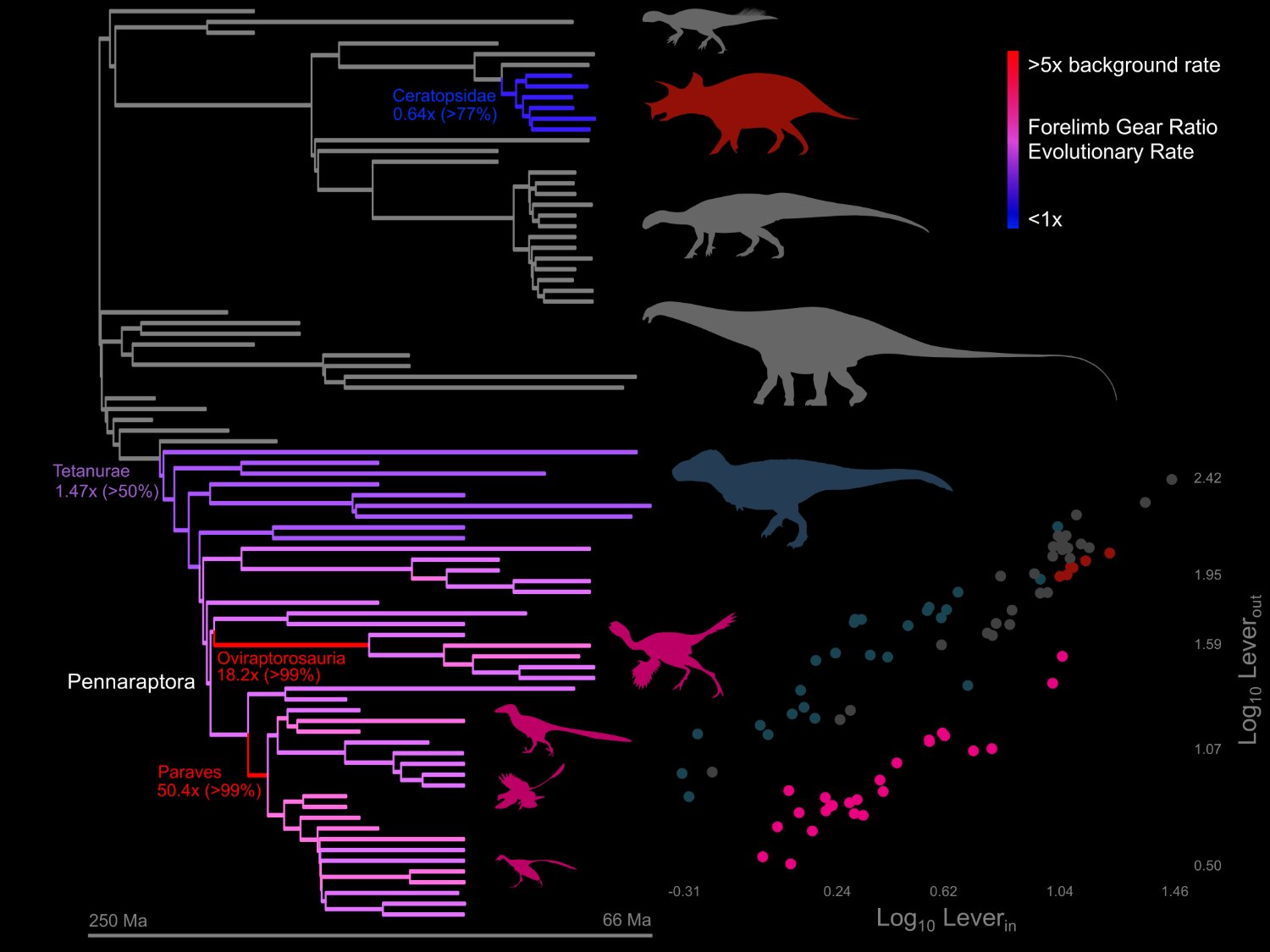Integrative Research
Genomics
Analyzing genome-wide molecular data and attributes of genome organization.
Paleontology
Sourcing from a rich fossil record to elevate sample sizes deeper in the tree of life.
Computational Methods
Using statistical models to integrate interdisciplinary data and test evolutionary hypotheses.
Research Highlights
Paleobiogeography & Global Change
My goal is to understand how organisms respond to periods of major global change and to reveal patterns of adaptation, extinction, and resilience that shaped life on Earth. My research leverages large datasets—from modern animal and fossil data in museums to genome sequences—and applies cutting-edge phylogenetic comparative methods and paleoclimate models to integrate interdisciplinary data within a deep-time context. This work bridges the deep past and present, fostering a holistic understanding of life’s diversity and its capacity to thrive in changing environments.
Wilson, Lauren N.*, Jacob D. Gardner*, John P. Wilson, Alex Farnsworth, Zackary R. Perry, Patrick S. Druckenmiller, Gregory M. Erickson, and Chris L. Organ. 2024. Global latitudinal gradients and body size diversity in dinosaurs and mammals. Nature Communications, 15: 2864. Link
Gardner, JD*, K Surya*, and CL Organ. 2019. Early Tetrapodomorph Biogeography: Controlling for Fossil Record Bias in Macroevolutionary Analyses. Comptes Rendus Palevol, 18(7): 609-709. Link
Paleobiology
The largest terrestrial vertebrates alive today walk on all four limbs to evenly distribute weight — think of an Elephant or a Giraffe. However, there are numerous theropod dinosaurs that are just as large but still bipedal — like Tyrannosaurus rex. How does an animal with great size maintain its bipedality and what benefits would that have? Colleagues and I used a combination of microscopic and statistical modeling techniques to study features on theropod dinosaur spines that would have helped maintain their bidepal posture.
LaBarge, Thomas W.†, Jacob D. Gardner, and Chris L. Organ. 2024. The evolution and ecology of gigantism in terror birds (Aves, Phorusrhacidae). Proceedings of the Royal Society B, 291(2021): 20240235. Link
Aguilar-Pedrayes, Isaura†, Jacob D. Gardner, and Chris L. Organ. 2024. The coevolution of rostral keratin and tooth distribution in dinosaurs. Proceedings of the Royal Society B, 291(2015): 20231713. Link
Wilson, JP, DC Woodruff, JD Gardner, HM Flora, JR Horner, and CL Organ. 2016. Vertebral Adaptations to Large Body Size in Theropod Dinosaurs. PLoS ONE, 11(7): e0158962. Link
Ancient DNA
Ancient DNA provides a unique window into bygone populations. Without such data, we would be ignorant of the many processes and events (admixture, migration, and selection) that gave rise to many populations today. Studies of cultural evolution and population history were long the purviews of archaeology and paleontology. Using extraction and analytical techniques adapted for degraded DNA, we can finally study the past from a genetic lens. I was fortunate to have learned many of these techniques during a fellowship and study abroad in China, where I studied in the Laboratory on Molecular Paleontology at the Institute of Vertebrate Paleontology and Paleoanthropology, Chinese Academy of Sciences. Here are some papers that came out of this experience:
Wang, W*, M Ding*, JD Gardner*, Y Wang*, … [25 authors] …, V Kumar, and Q Fu. 2021. Ancient Xinjiang Mitogenomes Reveal Intense Admixture with High Genetic Diversity. Science Advances, 7(14): eabd6690. Link
Zhang, M*, Yichen L*, Zhipeng L*, Peng L*, JD Gardner*, … [18 authors] …, EA Bennett, S Hu, and Q Fu. 2022. Ancient DNA reveals the maternal genetic history of East Asian domestic pigs. Journal of Genetics and Genomics, 49(6): 537–546. Link
Xue, Jiayang, Wenjun Wang, Jing Shao, Xiangming Dai, Zhouyong Sun, Jacob D. Gardner, … [14 authors] …, Nu He, and Qiaomei Fu. 2022. Ancient mitogenomes reveal the origins and genetic structure of the Neolithic Shimao population in northern China. Frontiers in Genetics, 13:909267. Link
Evolutionary Physiology
Genome size in vertebrate animals varies by over three orders of magnitude. Vertebrates also exhibit a wide range of metabolic rates and strategies for managing energy use. One hypothesis is that genome size influences metabolic rate because it affects cell size and, in turn, the movement of vital molecules across the cell membrane. We would, therefore, predict that metabolic rate variation across vertebrates correlates with genome size. Colleagues and I tested this hypothesis using recently-developed statistical models that take shared ancestry and rates of evolution into account.
Wilson, Lauren N.*, Jacob D. Gardner*, John P. Wilson, Alex Farnsworth, Zackary R. Perry, Patrick S. Druckenmiller, Gregory M. Erickson, and Chris L. Organ. 2024. Global latitudinal gradients and body size diversity in dinosaurs and mammals. Nature Communications, 15: 2864. Link
Gardner, JD, M Laurin, and CL Organ. 2020. The Relationship Between Metabolic Rate and Genome Size in Extant Vertebrates. Philosophical Transactions of the Royal Society B, 375(1793): 20190146. Link
Phylogenetic Methods
Phylogenetic comparative methods (PCMs) are commonly used to study evolution and adaptation. However, frequently used PCMs for discrete traits mishandle single evolutionary transitions. They erroneously detect correlated evolution in these situations. Using simulations, we find that rate parameter estimation, which is central for model selection, is poor in these scenarios due to small effective (evolutionary) sample sizes of independent character state change. We provide three general recommendations for researchers who encounter these common situations: i) create study designs that evaluate a priori hypotheses and maximize evolutionary sample sizes; ii) assess the suitability of evolutionary models—for discrete traits, we introduce the phylogenetic imbalance ratio; and iii) evaluate evolutionary hypotheses with a consilience of evidence from disparate fields, like biogeography and developmental biology.
Gardner, Jacob D.*, Joanna Baker*, Chris Venditti, and Chris L. Organ. 2025. Phylogenetically informed predictions outperform predictive equations in real and simulated data. Nature Communications, 16: 6130. Link
Gardner, JD, and CL Organ. 2021. Evolutionary Sample Size and Consilience in Phylogenetic Comparative Analysis. Systematic Biology, 70(5): 1061–1075. Link





